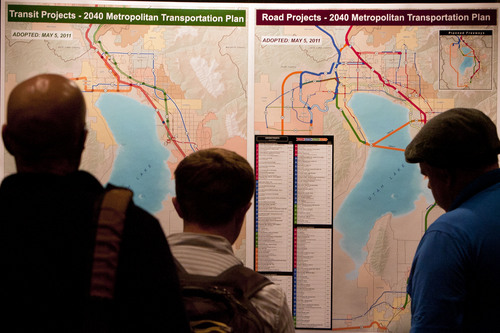This is an archived article that was published on sltrib.com in 2013, and information in the article may be outdated. It is provided only for personal research purposes and may not be reprinted.
Long-range development plans for Utah's urban centers have often received a flurry of attention when first announced, but many end up on dusty shelves in some government basement.
But never before in Utah's history has there been quite such a desperate need for a workable long-range plan. The already crowded Wasatch Front, where 90 percent of the state's population lives, is facing growth of about 67 percent in the coming three decades.
Where all those people will live, how they will travel from one point to another and how their basic needs will be met — for breathable air, clean water, social services — are questions that will be answered by knowledgeable people taking appropriate action, at best, or by inaction, at worst.
A group of such people called The Wasatch Choice for 2040 Consortium, including business and political leaders, planners and professors, is trying to figure out a formula that will allow newcomers and the substantial offspring of current Utahns to be absorbed while preserving the best of the Utah lifestyle. We hope they will be successful. In fact, the future well-being of all those who live in Utah hinges on their success.
Gov. Gary Herbert, announcing a separate statewide initiative called "Your Utah, Your Future," said, "In Utah, we don't believe in sitting back and seeing where growth will take us," But, unfortunately, that is exactly what has happened in many areas of the state.
In Davis County some of the most fertile soil in the country has been paved over and sold off for myriad small housing developments. The west side of Utah Lake, not long ago home to jackrabbits, is now crowded with subdivisions occupied by people who commute to work on narrow, congested roads.
Some consortium members do have a history of successful planning. In an effort beginning in 1997, Envision Utah claims to have reduced the impact of growth that was then expected to consume 300 square miles of open land by 2020. Following a campaign to promote development with less sprawl, Wasatch Front growth will require 100 square miles instead, Envision Utah leaders say.
The new consortium has drawn up a 30-year plan for the Wasatch Front that envisions that about a third of the expected growth will be people who will choose to live in new high-density town centers built around mass-transit stations that replace old rundown areas. They would drive less and consume less water and space.
Fortunately, such developments are already catching on. But the kind of changes in zoning and planning that will be needed to shoehorn in nearly 2 million more Utahns will require unprecedented cooperation among local city and county governments. Nevertheless, those changes in policy and attitude are greatly needed. This is one plan that we can't afford to shelve.



